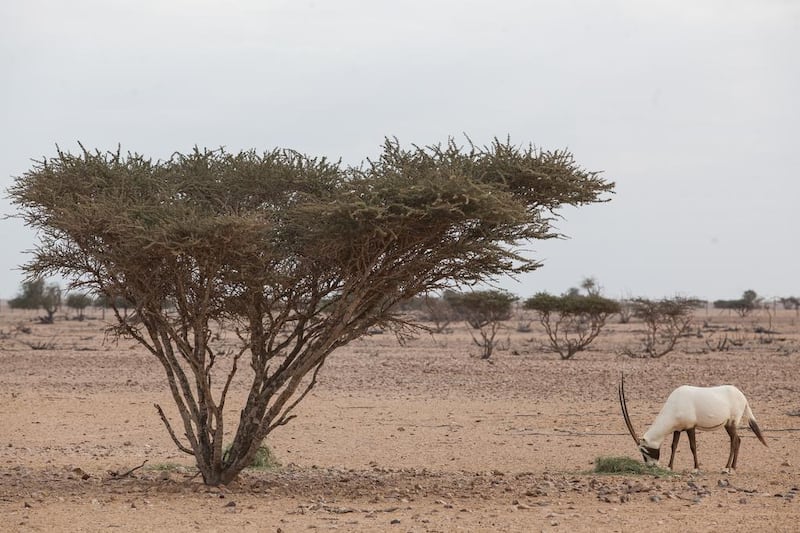HAIMA, OMAN // It is dawn at the Al Wusta wildlife reserve in Jiddat Al Harasis, Oman. The noise of a car door shutting startles an antelope as it licks the morning dew.
Dressed in military jackets and armed with M16 rifles, rangers Thany Al Harsusi and Ahmed Al Harsusi are ready for their working day — seven hours in a 4x4, patrolling the enclosure which protects the 2,824 square kilometre reserve.
“Poachers are our main occupation. We sometimes have to deal with people who have rifles. This year, we had two cases which could have turned to tragedy. Armed poachers came with several cars and one day they surrounded one of my rangers,” said Haithem Al Amri, the reserve manager.
The day before, he had been at the Nizwa court for yet another case of vandalism on the enclosure.
Thany Al Harsusi, 21, and Ahmed Al Harsusi, 25, drive fast through the vast, rocky desert, investigating the slightest sighting of smoke on the horizon, unknown tyre tracks or human footprints.
After dozens of kilometres, Thany spots a heap of abandoned bags. Inside, he finds 7mm bullets, the kind often used for hunting. They collect evidence and burn the rest.
Suddenly, a car appears in the distance and they give chase. The driver is a camel rider they know but Ahmed insists on checking over the car.
“In case of direct confrontation with poachers, which hasn’t happened to me yet, we have the right to fire once in the air if they do not cooperate. However, if they flee or shoot at us, we can fire at them,” he explains.
Among the species protected in the reserve is the Arabian Oryx, which have been hunted since ancient times for their meat, skin and the supposed medicinal properties of their blood. The last wild oryx in Oman were reportedly shot in 1972 and the species declared extinct in the wild. But in 1980, 10 were reintroduced into the reserve. According to the Arabian Oryx Regional Conservation Strategy and Action Plan, their numbers increased steadily, exceeding 400 by 1996.
But in 2007, the Omani state reduced the size of the reserve by 90 per cent so that it could conduct oil exploration. The reserve had been on the Unesco list of world heritage sites since 1994. In an unprecedented move, Unesco removed it.
Wildlife habitat has been shrinking ever since. “The animals’ space has been declining and many species became scarce,” said Hani Al Saadi, 28, a biologist at Al Wusta. “These people of the oil company came, dug everything, destroyed, and some filmed themselves hunting animals. Before, there was a real diversity necessary to oryx. What’s left today? Hunters.”
Around 20 oryx bred in captivity were recently released as part of the reintroduction programme. “We have 637 captive individuals. Sometimes we release some. I saw three yesterday in the reserve, but many were killed by hunters,” Mr Al Saadi said.
The enclosure of the Al Wusta reserve in 2009 is still a hotly-debated subject among the Harsusi tribe, who have officially been entrusted with protecting the oryx since 1980 and are employees of the reserve. Mohammed Haziz, 70, a member of the tribe who was head ranger from 1980 to 2007, says enclosure was necessary.
“If there were no barrier, animals would go towards new houses and roads,” he said. “And we have a big poaching problem. How can you secure a protected zone against hunters without enclosures? And this oil company which took all the space!”.
His fellow tribesman, Abdullah Ahmad, 50, disagrees. He believes the Omani state built the enclosure “because they consider we are not able any more to protect oryx as we did for decades”.
Sheikh Salem Chamli Al Harsusi is in favour of oil exploration. “Oil companies are good things, because they offer job opportunities for us. Regarding the enclosure, I am against it, because that goes against our traditions, but we shall deal with it,” he said.
There is no doubt that oil is a far more lucrative revenue source than tourism for Oman. According to professor Shaul Gabbay, director of the Global Research Institute Posner Center for International Development in the US and an expert on the Gulf region, tourism accounts for only 3 per cent of Oman’s GDP at best, while as of December 2015 oil made up 44 per cent. “The comparison between the petroleum industry and the tourist sector is not a fair one,” he said.
While the Harsusis continue to argue among themselves, the number of wild oryx in Oman remains close to zero. And while the government plans to attract more than five million international visitors a year by 2040, the Al Wusta reserve does not really attract any tourists anymore.
foreign.desk@thenational.ae





